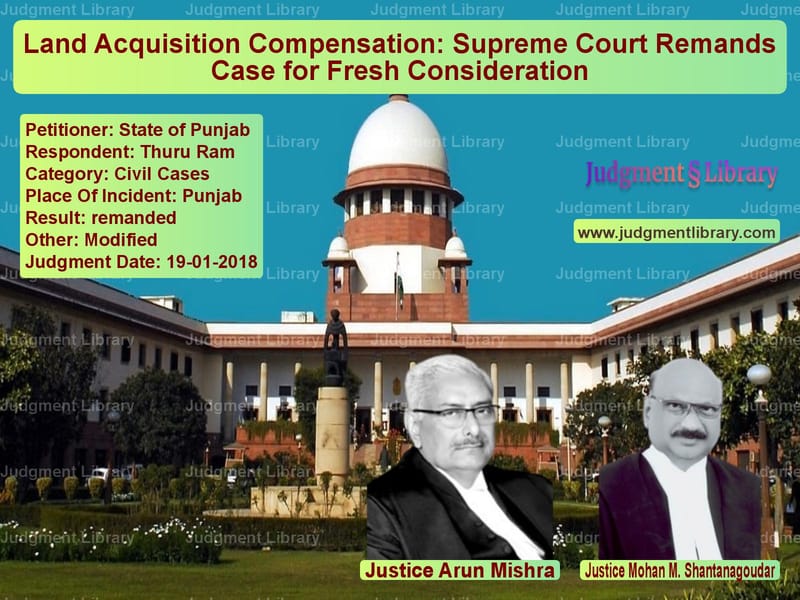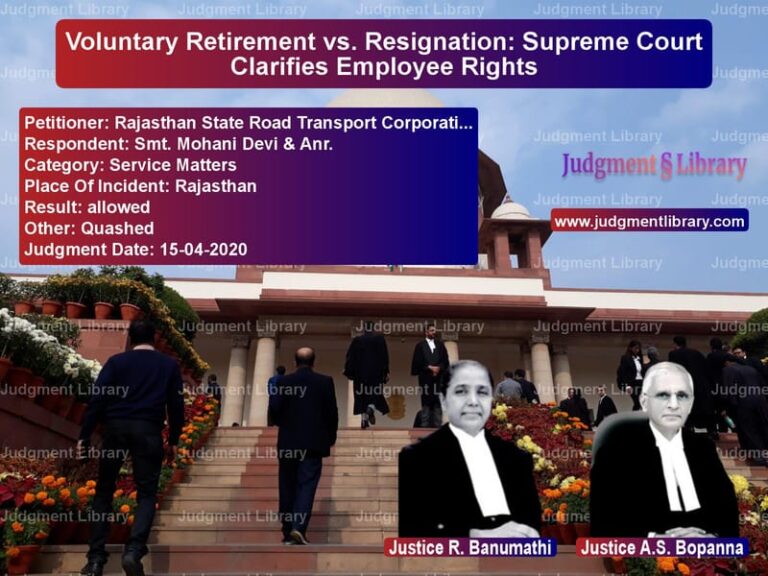Land Acquisition Compensation: Supreme Court Remands Case for Fresh Consideration
The case of State of Punjab vs. Thuru Ram revolves around a dispute over compensation for fruit trees standing on acquired land. The Supreme Court, in its judgment dated January 19, 2018, set aside the Punjab and Haryana High Court’s decision and remanded the case for fresh consideration.
This ruling highlights the importance of accurate assessment in land acquisition cases and ensures that compensation for affected landowners is based on proper evaluation.
Background of the Case
The respondent, Thuru Ram, owned land in Punjab that was acquired for the construction of a Hydel Channel. The government issued a notification under Section 4 of the Land Acquisition Act, 1894, on January 12, 1990, followed by a declaration under Section 6 on February 28, 1990.
The Land Acquisition Collector initially awarded compensation, including an amount for fruit trees on the acquired land, through a supplementary award on March 10, 1993. However, the respondent was dissatisfied with the amount and sought a reference, which was dismissed by the Reference Court. He then approached the Punjab and Haryana High Court.
High Court’s Ruling
The High Court allowed the respondent’s appeal and increased the compensation to Rs. 5,77,377, including statutory benefits under Sections 23(1-A), 23(2), and 28 of the Land Acquisition Act. The State of Punjab challenged this decision before the Supreme Court.
Key Legal Issues
- Whether the High Court properly assessed the number and category of fruit trees.
- Whether the expert valuation reports presented by both parties were given due consideration.
- Whether the increase in compensation was justified based on the available evidence.
Petitioner’s Arguments (State of Punjab)
The State of Punjab, represented by its counsel, argued:
“The High Court overlooked critical evidence regarding the number and valuation of trees. The assessment relied upon by the High Court was not accurate, leading to an unjustified increase in compensation.”
The State relied on the expert report of RW-2 (Horticulture Development Officer), which classified the trees as ‘D’ category, significantly lowering their valuation compared to what the High Court awarded.
Respondent’s Arguments (Thuru Ram)
The respondent maintained:
“The fruit trees were well-maintained and productive. The expert valuation report relied upon by the respondent, Exhibit A.1, was prepared by a qualified expert and should be considered for compensation.”
The respondent’s expert, AW-2 (Sunder Singh), a retired District Agricultural Officer, assessed the trees at a much higher value.
Supreme Court’s Analysis
The Supreme Court found that the High Court had not thoroughly examined the evidence, particularly regarding the number of trees and their classification.
Key observations included:
- The respondent initially claimed 396 fruit trees but later stated in his deposition that there were only 250 trees.
- The land records suggested an agricultural land use, with orchard entries added later without proper authentication.
- The respondent’s expert estimated the total value of the trees at Rs. 6,35,114.70, while the State’s expert provided a much lower valuation.
- The reference court had relied on factual inconsistencies to dismiss the claim, but the High Court overlooked these issues.
The Court concluded:
“In view of the above, it is clear that the High Court has overlooked certain material aspects of the evidence before coming to the conclusion. The High Court needs to consider the entire material in proper perspective afresh.”
Final Ruling
- The Supreme Court set aside the High Court’s judgment.
- The matter was remitted to the High Court for fresh adjudication.
- The High Court was directed to reconsider the case based on a full assessment of all evidence.
Implications of the Judgment
The judgment has significant implications for land acquisition cases:
- Ensures Fair Compensation: The ruling reinforces the importance of accurate valuation of land and trees in acquisition cases.
- Prevents Overcompensation or Undercompensation: Courts must thoroughly assess evidence before modifying compensation awards.
- Strengthens Judicial Review: The Supreme Court’s intervention ensures that High Courts exercise due diligence in evaluating claims.
Conclusion
The Supreme Court’s decision in State of Punjab vs. Thuru Ram emphasizes the need for meticulous scrutiny in land acquisition cases. By remanding the matter for fresh consideration, the Court upheld the principle that compensation must be based on an accurate and fair evaluation of evidence.
This ruling serves as a reminder that courts must critically analyze expert reports and land records before determining compensation in land acquisition disputes.
Don’t miss out on the full details! Download the complete judgment in PDF format below and gain valuable insights instantly!
Download Judgment: State of Punjab vs Thuru Ram Supreme Court of India Judgment Dated 19-01-2018.pdf
Direct Downlaod Judgment: Direct downlaod this Judgment
See all petitions in Property Disputes
See all petitions in Damages and Compensation
See all petitions in Landlord-Tenant Disputes
See all petitions in Judgment by Arun Mishra
See all petitions in Judgment by Mohan M. Shantanagoudar
See all petitions in Remanded
See all petitions in Modified
See all petitions in supreme court of India judgments January 2018
See all petitions in 2018 judgments
See all posts in Civil Cases Category
See all allowed petitions in Civil Cases Category
See all Dismissed petitions in Civil Cases Category
See all partially allowed petitions in Civil Cases Category







